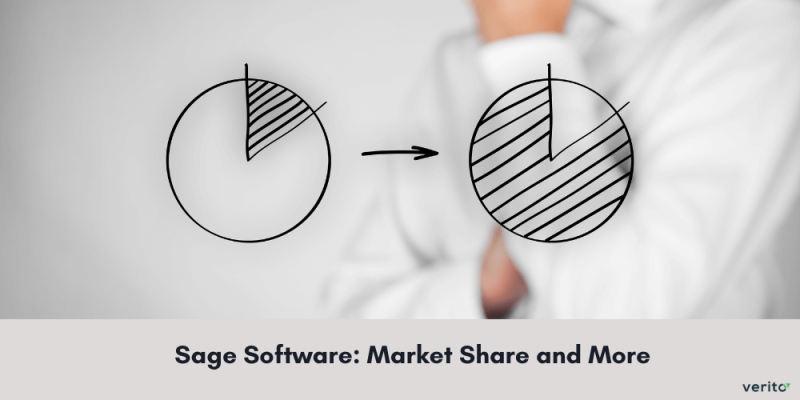The significance of efficient and reliable software solutions cannot be overstated in the field of accounting. Among the myriad of software options available, Sage software has emerged as a prominent player. It has attracted different types of businesses across the globe. The best part is that its diverse suite of business management features has not only weathered the test of time but also maintained a robust foothold in the competitive tech market.
The story of Sage Software combines innovation, adaptability, and a keen understanding of the evolving needs of businesses across various sectors. From small startups to multinational corporations, Sage has proven its mettle as a reliable partner in managing finances, streamlining operations, and driving growth.
Wondering what sets Sage apart from its rivals and how it maintains its leadership position in a field marked by rapid technological advancements and fierce competition? Let’s peer into its landscape in terms of statistics and more. This blog post promises to provide a comprehensive and insightful overview of Sage Software’s journey, market presence, and its ongoing quest to redefine the future of business technology.
The Basics of Sage Software
Sage Software was founded in 1981 and has been a driving force in the world of business software since then. From its modest beginnings as a small startup in Newcastle, England, the company has grown into a global powerhouse serving millions of businesses worldwide.
From the very beginning, David Goldman – Sage founder, was on a mission to simplify and streamline financial and business management processes for organizations of all sizes. He recognized the complexities people faced in managing their finances and saw an opportunity to leverage technology for efficiency. This commitment to innovation has remained at the heart of this software and led to the creation of groundbreaking software solutions that continue transforming how businesses operate.
One of Sage’s key strengths lies in its diverse portfolio of software offerings. Unlike its competitors that specialize in narrow niches, Sage takes a comprehensive approach and provides solutions that address the full spectrum of business needs. Whether it’s accounting, payroll, or Enterprise Resource Planning (ERP), Sage has a solution tailored to the unique requirements of various industries and business sizes.
Also Read: Using the Best Features of Sage software? You Also Need This
Sage Success Timeline
| Year | Description |
| 1981 | Founder in Newcastle |
| 1989 | Listing on the London Stock Exchange |
| 1991 | Entry into the US Market |
| 1992 | Entry into the French Market |
| 1999 | Entry into the Swiss and Portuguese Markets |
| 2000 | Reached the milestone of 2 million global customers |
| 2005 | Entry into the Polish market |
| 2009 | Reached the milestone of 6 million global customers |
| 2017 | Strategic partnership announcement with Fairsail |
| 2021 | Strategic partnership announcement with Tide |
For more information on what happened when with Sage, click here.
Sage Market Share Data
Given below are various Sage market statistics you should know:
- Sage software has a 25.94% market share in the IT service category.
- More than 29,000 companies/customers use Sage software (as per the reliable source of information in use and the numbers available in public).
- The top three competitors of Sage include NetSuite, Red Hat, and ServiceNow ITSM.
- Particularly Sage 50 software version has around 6.8% market share in the accounting category.
- Sage ERP, in particular, has a 3.17% market share in the ERP category. Some of its top competitors include Microsoft Dynamics, Workday, SAP ERP, to name a few.
Recommended Read:
Sage 50cloud vs. QuickBooks Pro: Which One Should You Select?
Sage Usage Based on Industry-Specific Usage
Given below is the list of the top industries where Sage software is used:
- Accounting
- Payroll
- Recruitment
- Construction
- Marketing
- Manufacturing
- Engineering
Recommended Read: Application Hosting: Market Size, Key Trends, and More
Sage Usage Based on the Number of Employees in an Organization
The following table highlights the distribution of companies in relation to the corresponding number of employees:
| Number of Employees | Number of Organizations Using Sage (Apx.) |
| 0-9 | 4400 |
| 10-19 | 2600 |
| 20-49 | 6700 |
| 50-99 | 3000 |
| 100-249 | 5400 |
Sage Usage Based on Geography
Here is the list of countries in which Sage software is used:
- United States
- United Kingdom
- Canada
- France
- South Africa
- Ireland
- Australia
List of Industries Where Sage 50 is Used
Given below is the list of the top industries where Sage 50 software is used:
- Construction
- ITES
- Accounting
- Computer Software
- Retail
- Higher education
- Non profits
- Financial services
Sage 50 Usage Based on Geography
Here is the list of countries where Sage 50 software is used:
- United States
- United Kingdom
- Canada
- Ireland
- France
- Australia
- India
- Germany
Also Read: How to Host Sage Software on the Cloud?
Sage 50 Usage Statistics Based on Business Revenue
The following table highlights the companies where Sage 50 software is used in terms of the company revenue:
| Revenue (in $Million) | Number of Organizations Using QuickBooks (Apx.) |
| Between 0 to 1 Million | 2900 |
| Between 1 to 10 Million | 8300 |
| Between 10 to 50 Million | 3800 |
| Between 50 to 100 Million | 1000 |
| Between 100 to 200 Million | 700 |
| Between 200 to 1000 Million | 1000 |
| More than 1000 Million | 1100 |
References:
- Sage data guide
- Sage 50 usage guide
- Sage ERP usage guide
- Picking Sage Hosting Provider? 4 Key Things to Look For
Disclaimer:
The information presented in this blog post is derived primarily from data obtained from reputable reference sources and meticulously chosen research materials. While we have taken the utmost care to ensure accuracy and reliability, it is important to acknowledge that statistics, market share data, and competitor insights may undergo changes over time.
For this reason, we strongly encourage our readers to independently verify the most current information by consulting official reports, industry publications, and the latest data from authoritative sources. This blog post is intended to serve as an informative overview of the subject matter and should not be regarded as a replacement for professional advice or research.
The authors and publishers of this blog post do not assume responsibility for any decisions or actions taken based on the information presented herein. We advise readers to exercise due diligence and seek guidance from relevant experts or industry professionals for specific and up-to-date insights.







